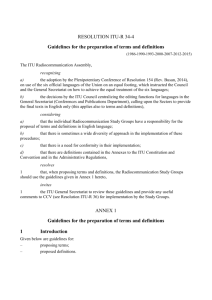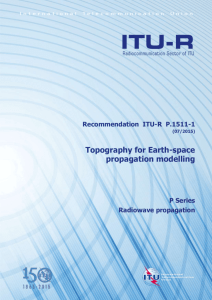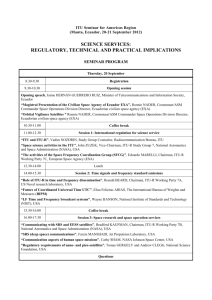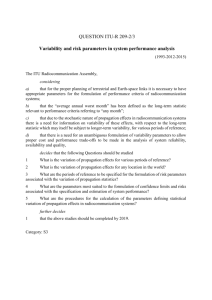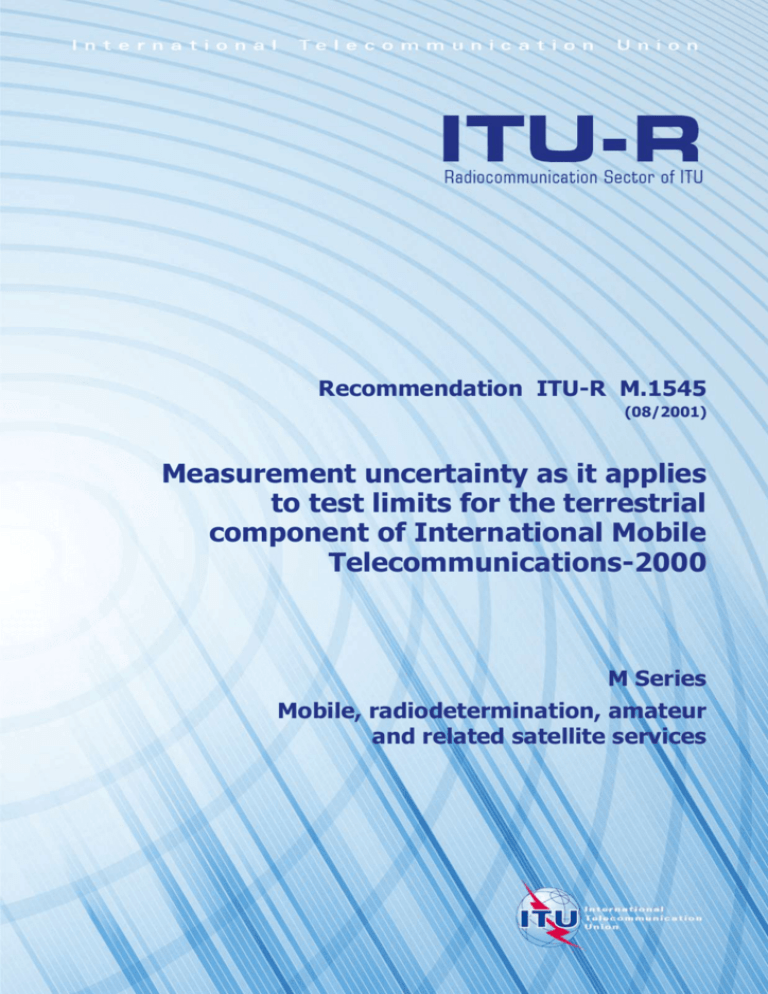
Recommendation ITU-R M.1545
(08/2001)
Measurement uncertainty as it applies
to test limits for the terrestrial
component of International Mobile
Telecommunications-2000
M Series
Mobile, radiodetermination, amateur
and related satellite services
ii
Rec. ITU-R M.1545
Foreword
The role of the Radiocommunication Sector is to ensure the rational, equitable, efficient and economical use of the
radio-frequency spectrum by all radiocommunication services, including satellite services, and carry out studies without
limit of frequency range on the basis of which Recommendations are adopted.
The regulatory and policy functions of the Radiocommunication Sector are performed by World and Regional
Radiocommunication Conferences and Radiocommunication Assemblies supported by Study Groups.
Policy on Intellectual Property Right (IPR)
ITU-R policy on IPR is described in the Common Patent Policy for ITU-T/ITU-R/ISO/IEC referenced in Annex 1 of
Resolution ITU-R 1. Forms to be used for the submission of patent statements and licensing declarations by patent
holders are available from http://www.itu.int/ITU-R/go/patents/en where the Guidelines for Implementation of the
Common Patent Policy for ITU-T/ITU-R/ISO/IEC and the ITU-R patent information database can also be found.
Series of ITU-R Recommendations
(Also available online at http://www.itu.int/publ/R-REC/en)
Series
BO
BR
BS
BT
F
M
P
RA
RS
S
SA
SF
SM
SNG
TF
V
Title
Satellite delivery
Recording for production, archival and play-out; film for television
Broadcasting service (sound)
Broadcasting service (television)
Fixed service
Mobile, radiodetermination, amateur and related satellite services
Radiowave propagation
Radio astronomy
Remote sensing systems
Fixed-satellite service
Space applications and meteorology
Frequency sharing and coordination between fixed-satellite and fixed service systems
Spectrum management
Satellite news gathering
Time signals and frequency standards emissions
Vocabulary and related subjects
Note: This ITU-R Recommendation was approved in English under the procedure detailed in Resolution ITU-R 1.
Electronic Publication
Geneva, 2011
ITU 2011
All rights reserved. No part of this publication may be reproduced, by any means whatsoever, without written permission of ITU.
Rec. ITU-R M.1545
1
RECOMMENDATION ITU-R M.1545*, **
Measurement uncertainty as it applies to test limits for the terrestrial
component of International Mobile Telecommunications-2000
(Question ITU-R 229/8)
(2001)
Scope
This Recommendation describes the application of measurement uncertainty to test limits when
devices for terrestrial component of IMT-2000 are tested for conformance. Consistent with industry
practice, it is recommended that the shared risk principle should be used for all tests and that any
relaxation of core specification limits should be evaluated on a case-by-case basis.
The ITU Radiocommunication Assembly,
considering
a)
that Recommendation ITU-R M.1457 addresses the detailed specifications of the radio
interface of International Mobile Telecommunications-2000 (IMT-2000);
b)
that it is reasonable to allow in practice some measurement uncertainty in the measurement
method, measurement equipment and measurement test bench when the device is to be tested from
a regulatory viewpoint;
c)
that a device that is manufactured in one country and passes a conformance test based on
regulation of that country may not be well accepted by the regulator of another country, not due to
actual inadequacy of the equipment but because of difference in the concepts employed for handling
measurement uncertainty;
d)
that it is essentially important to achieve a common global understanding of how
measurement uncertainty is applied when test limits are defined, in conjunction with how that is
incorporated into pertinent specifications;
e)
that from a technical perspective, in a case that the measurement uncertainty can be
reasonably defined, the following three methods lead to the same result:
–
“Never fail a good device under test (DUT)” principle applied to a test limit equals to the
core specification value, where core specification value and measurement uncertainty are
separately defined (see Annex 1, Fig. 1);
–
“Shared risk” principle applied to a test limit calculated by relaxing the core specification
value by measurement uncertainty, where core specification value and measurement
uncertainty are separately defined (see Annex 1, Fig. 2);
–
“Shared risk” principle applied to a test limit which equals the core specification value that
includes measurement uncertainty (see Annex 1, Fig. 3),
*
This Recommendation should be brought to the attention of Radiocommunication Study Group 1.
**
Radiocommunication Study Group 5 made editorial amendments to this Recommendation in
November 2010.
2
Rec. ITU-R M.1545
recommends
1
that maximum allowable measurement uncertainty as it applies to test limits should be
defined as a unique and consistent value associated with one or a combination of measurement
methods and measurement equipment to be used, when the device for terrestrial component of
IMT-2000 is to be tested for conformance;
2
that in order to be consistent with industry practice, the shared risk principle should be used
for all tests and that it may be decided to relax the core specification value by a certain relaxation
value that should be evaluated on a case-per-case basis taking into account different factors such as
test system measurement uncertainty (test equipment uncertainty, mismatch, and so on), and
criticality for system performance;
3
that it should be clearly indicated where the relaxation value is specified;
4
that in case the measurement uncertainty cannot be reasonably and clearly defined, the
“shared risk” principle should be applied to core specification value without any relaxation.
NOTE 1 – Definitions applicable to this Recommendation:
Measurement uncertainty: error in measurement associated with one or a combination of
measurement methods and measurement equipment to be used when the device is to be tested for
conformance.
Core specification value: value defined in the core specification.
Test limit: threshold considered in a test to assess compliance of the device; it might be equal,
relaxed or tightened compared to the corresponding core specification value.
“Never fail a good DUT” principle: measurement results are compared with test limits tolerating
failures up to the measurement uncertainty (i.e. the DUT is considered to pass if the measurement
result is within the test limits + tolerance up to measurement uncertainties).
“Shared risk” principle: measurement results are compared with test limits (i.e. the DUT is
considered to pass if the measurement result is within the test limits).
Rec. ITU-R M.1545
3
ANNEX 11
Examples of two criteria using “never fail a good DUT”
and “shared risk” principles
FIGURE 1
“Never fail a good DUT” principle where core specification value
and measurement uncertainty are separately defined
Area where DUT fails
conformance test
–39 dBm
+2 dB
–41 dBm
Test limit
–2 dB
Area where DUT
passes conformance
test
Example:
– Core specification: no greater than –41 dBm
– Measurement uncertainty: ±2 dB
1545-01
FIGURE 2
Application of “shared risk” principle where test limit is calculated by relaxing the core
specification value by measurement uncertainty (when core specification value and
measurement uncertainty are separately defined)
Area where DUT fails
conformance test
–39 dBm
Test limit
+2 dB
–41 dBm
–2 dB
Example:
– Core specification: no greater than –41 dBm
– Measurement uncertainty: ±2 dB
1
The confidence level is not considered in this Recommendation.
Area where DUT
passes conformance
test
1545-02
4
Rec. ITU-R M.1545
FIGURE 3
Application of “shared risk” principle where the test limit is the
core specification value that includes measurement uncertainty
Area where DUT fails
conformance test
Test limit
–39 dBm
Area where DUT
passes conformance
test
Example:
– Core specification: (including measurement uncertainty of ±2 dB): no greater than –39 dBm
1545-03

